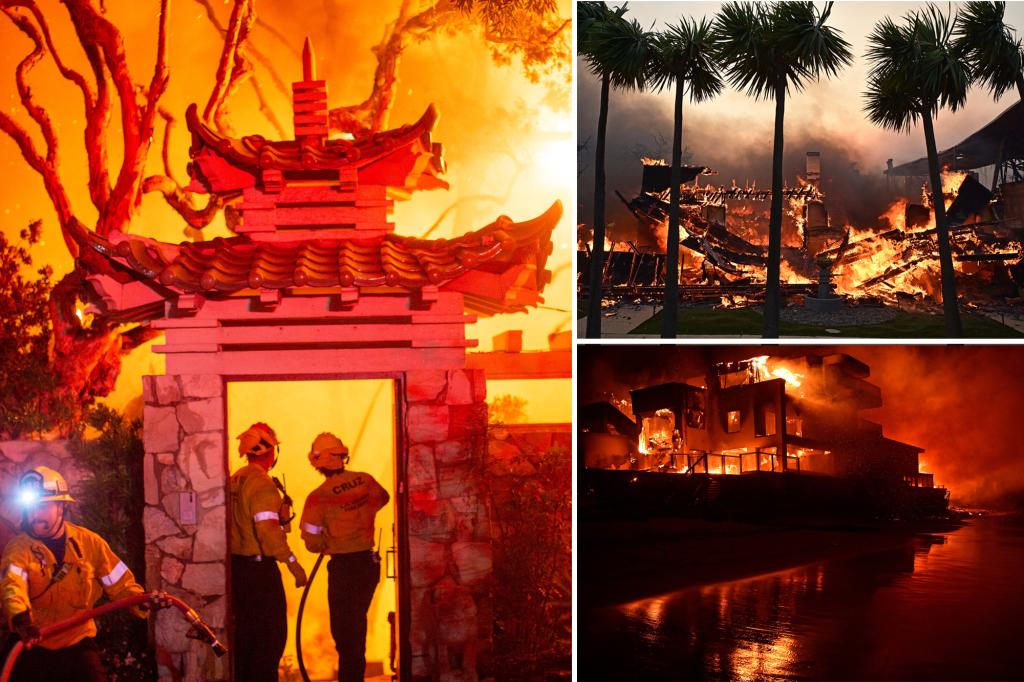The devastating Palisades Fire, which ravaged Los Angeles and tragically claimed at least eight lives, may have been a resurgence of an earlier, smaller fire ignited by New Year’s Eve fireworks, according to an investigative report. The initial fire, seemingly extinguished, left behind smoldering embers and scorch marks, creating a tinderbox susceptible to reignition. Strong Santa Ana winds, known for their dry, forceful nature, likely fanned these dormant embers back to life, transforming them into an uncontrollable inferno just six days later. This analysis, based on satellite imagery, radio communications, videos, and interviews, points to a possible chain of events connecting the two fires, highlighting the persistent danger posed by even seemingly controlled blazes in dry, windy conditions.
The investigation also reveals a significant discrepancy in response times between the initial New Year’s Eve fire and the subsequent Palisades Fire. While the first fire prompted a swift and effective response, the second was met with delays, hampered by high winds and strained resources. Residents expressed frustration over the slower response time, noting a stark contrast to the efficient handling of the earlier fire. One resident, Michael Valentine, who witnessed both fires, described the difference in response as “night and day.” He recounted busy phone lines when attempting to report the nascent Palisades Fire and a prolonged period before witnessing any firefighting presence, either on the ground or in the air. This delayed response allowed the fire to gain momentum rapidly, contributing to its destructive power.
The wind-driven nature of the Palisades Fire, coupled with the dry conditions prevalent in the area, created an environment ripe for rapid fire spread. The combination of drought and intense winds served as a catalyst, not only for the initial ignition but also for the rapid escalation of the blaze. These conditions, known to exacerbate fire behavior, made containment extremely challenging and increased the risk of reignition from existing embers. Expert analysis supports the theory of rekindling, emphasizing the potential for smoldering fires to transition back to flaming under such conditions. This underscores the importance of comprehensive fire suppression and monitoring, even after a fire appears to be under control.
The investigation delves into the timeline of the Palisades Fire, tracing its likely origins back to the Temescal Ridge area in the Santa Monica Mountains, the same location as the New Year’s Eve fire. Satellite imagery captured approximately 20 minutes after the Palisades Fire began shows smoke emanating from an area that overlaps with the burn scar from the previous fire. This visual evidence strengthens the link between the two incidents, supporting the hypothesis that the Palisades Fire was a reignition. The New Year’s Eve fire, though relatively small, covering only four acres, took over four hours to contain even under relatively calm wind conditions, indicating the potential for persistent embers.
Further evidence supporting the theory of reignition comes from eyewitness accounts. A hiker near the origin point just an hour before the Palisades Fire erupted reported smelling smoke, which subsequently dissipated. This suggests the presence of smoldering embers or underground burning, invisible yet active, waiting for the right conditions to flare up. Another resident attributed the entire sequence of events to the irresponsible use of fireworks on New Year’s Eve, a recurring issue in the area. This account highlighted the dry conditions and the predictable Santa Ana winds, emphasizing the foreseeable danger of igniting fires in such a vulnerable environment.
While the exact cause of the Palisades Fire remains under investigation, the evidence strongly suggests a connection to the New Year’s Eve fire. The combination of dry conditions, strong Santa Ana winds, and the potential for rekindling from the earlier fire paints a compelling picture. Both state and federal investigators are actively examining the origin point of the Palisades Fire, seeking definitive proof to confirm this theory. Regardless of the final determination, the incident underscores the crucial need for heightened fire safety awareness, responsible fire management practices, and robust emergency response capabilities in fire-prone regions, especially during periods of high wind and drought.

